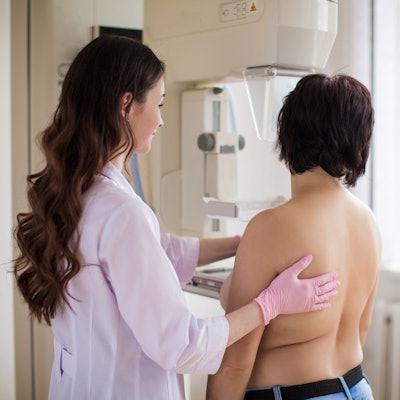
Native Hawaiian women, Filipino women, and women who received a diagnosis of ductal carcinoma in situ (DCIS) before 2000 are more likely to develop second breast cancers, according to research published October 20 in JAMA Network Open.
A team led by Dr. Kekoa Taparra, PhD, from Stanford Health Care in California found that these women are more likely to develop both invasive ipsilateral second breast cancer and invasive contralateral second breast cancer. The group also found that Japanese women and younger women were more likely to develop invasive ipsilateral second breast cancer.
"This study highlights racial and ethnic disparities in the risk of developing invasive second breast cancer that were not, to our knowledge, previously appreciated among Native Hawaiian women and subpopulations of Asian American women compared with white women," Taparra and colleagues wrote.
The number of DCIS diagnoses in recent years has increased due in part to improvements in mammography screening. While clinical outcomes in these cases are usually favorable, the researchers said that up to 40% of women develop a second breast cancer after DCIS, 28% of which are invasive breast cancers.
Therapeutic and follow-up strategies for DCIS are being discussed to prevent overtreatment of women with low-risk disease and undertreatment of women at high risk of developing an invasive second breast cancer. The study authors said this makes finding out which women are at risk important.
Native Hawaiian or Other Pacific Islander (NHPI) individuals are one of the five federally recognized U.S. racial categories. However, research has shown that NHPI individuals can experience major health disparities compared with other racial and ethnic groups. These individuals have some of the highest cancer mortality rates, the highest chronic disease incidence rates, and the shortest life spans.
NHPI women have a higher overall incidence of cancer, including breast cancer, than all Asian American women. Native Hawaiian women have among the highest rates of breast cancer, nearly four times higher than those among Asian women, the researchers said.
Taparra et al wanted to understand the prevalence of invasive second breast cancers among the Hawaiian population and identify risk factors associated with developing invasive ipsilateral second breast cancer and invasive contralateral second breast cancer.
In their retrospective study, they looked at deidentified data from 6,221 female Hawaiian residents ages 20 or older who received a diagnosis of DCIS between 1973 and 2017. Of these, 4,817 were 50 or older.
The five most populous ethnic groups were compared. These included Chinese, Filipino, Japanese, Native Hawaiian, and white.
Of the total, 2,270 women were Japanese (37%), 1,411 were white (23%), 840 were Filipino (14%), 821 were Native Hawaiian (13%), and 491 were Chinese (8%). Women of other minority race and ethnicity collectively comprised 6% of cases (388).
Out of the total number, 4,452 (72%) received a DCIS diagnosis between 2000 and 2017, and 444 (7%) developed invasive second breast cancers. From the latter number, 190 developed invasive ipsilateral second breast cancer and 254 developed invasive contralateral second breast cancer.
| Adjusted odds ratios of Hawaiian population with DCIS who developed second breast cancers | ||||||
| White (reference) | Chinese | Japanese | Filipino | Native Hawaiian | Other minority race/ethnicity | |
| Invasive ipsilateral second breast cancer | 1 | 1.09 | 1.58 | 1.94 | 3.28 | 1.63 |
| Invasive contralateral second breast cancer | 1 | 0.82 | 1.30 | 1.70 | 1.69 | 0.63 |
The researchers also found women who developed invasive ipsilateral second breast cancer to be more likely younger than 50 years (adjusted odds ratio [aOR], 1.49) and untreated (aOR, 2.29).
Compared with breast-conserving surgery alone, a decreased likelihood of invasive ipsilateral second breast cancer was found among women receiving breast-conserving surgery and radiotherapy (aOR, 0.45), breast-conserving surgery and systemic treatment with or without radiotherapy (aOR, 0.40), mastectomy only (aOR, 0.23), and mastectomy and systemic treatment (aOR, 0.57).
Risk of both invasive ipsilateral second breast cancer and invasive contralateral second breast cancer decreased in the later years of diagnosis (2000-2017) compared with the earlier years (1973-1999). The team said this may be because of increased mammography screening between 1987 and 2000, where rates increased from 29% to 70% during this period.
The researchers said their findings may help oncologists understand the association of race and ethnicity with the risk of developing invasive second breast cancers in these understudied populations.
"[W]e were able to investigate breast cancer disparities among NHPI individuals that have not been previously appreciated," the study authors wrote.
In an accompanying editorial, Linda Lindström, PhD, from the Karolinska University Hospital in Sweden said the study underlines the importance of the racial and ethnic disparities and a younger age in the rates of invasive breast disease.
Lindström also echoed studies authors in that these findings should help with improving understanding the risk factors linked to developing invasive breast cancer after DCIS, as well as better managing patients at higher and at lower risk of breast cancer.




















